
gbVRML - Online Help
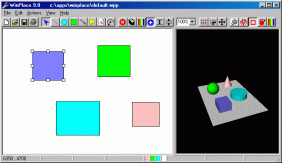
 This page provides the latest online Help information for gbVRML.
This page provides the latest online Help information for gbVRML.
 Return to top of document
Return to top of document
Features
gbVRML offers a wide range of easy-to-use features.
2D Features
gbVRML provides an easy-to-learn, intuitive interface designed to allow
rapid generation of a design. The main window is where most Winplace actions
take place, but several secondary windows are available which are used to
create the design. Key features of gbVRML include:
- Use mouse to create, size and move parts
- Layout grid with snap-to-grid part placement
- Multiple part shapes, including rectangles and circles
- Text support
- User-defined properties
- Cut and paste selection/placement
- Part grouping
- Property summaries
- Parts Library
3D Features
The 3D imaging of gbVRML is the best part. gbVRML creates VRML files
on the fly and uses a built-in VRML viewer to view the results.
- Realtime inline VRML viewer
- VRML primitives, including text
- Object textures
- Insertion of external VRML objects
- View/edit of VRML source code
- Manual edit of VRML source code
Export/Reporting Features
Making the best of your gbVRML design includes being able to use the
results in other applications. Support for the following export options
enhances your ability to use your gbVRML designs.
- WMF (compatible with Windows applications)
- BMP (compatible with Windows applications)
- WRL (VRML file type)
- Excel (parts lists)
- Clipboard
- Printed layout/part lists
 Return to top of document
Return to top of document
Examples
gbVRML allows you to create a wide variety
of designs. Here are some examples to whet your appetite.
Simple Objects

Transparent Objects
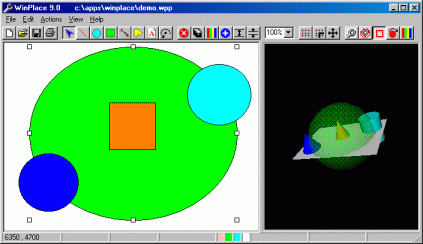
Floating Objects
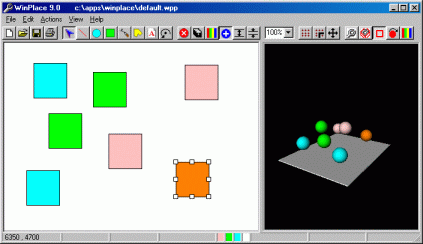
Floating Objects

Textures
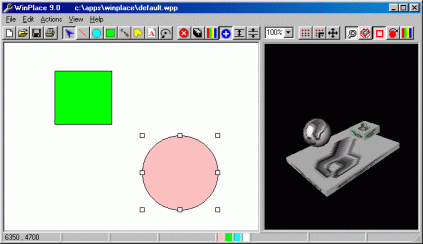
Textures on Top
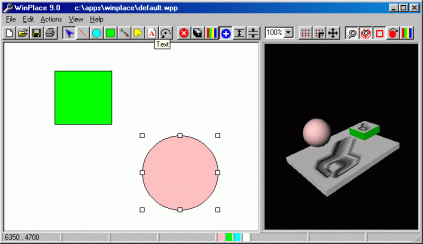
 Return to top of document
Return to top of document
Main Window
gbVRML allows the user to create a 2D design by adding objects to a
2D drawing pane (see the main window image below). Additional properties
may be entered for each object (in the Part Properties window) and the
results are immediately shown in the 3D viewing pane.
gbVRML uses the concept of a 'layout', which is a surface on which the
objects are said to be placed. This layout, which may be optionally be
excluded from the project, is included in the 3D viewing pane just like
any other object which has been added to the gbVRML project.
The four basic sections of the main window are the menus, toolbar, 2D
drawing pane, and VRML viewer. All design activity is performed within
the 2D drawing pane and the 3D results of the design are instantly displayed
within the 3D viewing pane. Note that there is a splitter bar which resizing
of the relative sizes of the 2 panes.
Note that gbVRML requires that you set your screen resolution to at least
800x600.
Menu and toolbar operation is discussed below, including a context menu
available by right mouse clicking on the 2D drawing pane.
 Return to top of document
Return to top of document
Toolbars
gbVRML has an extensive toolbar to help
you design your project quickly. The toolbar can be broken
into the following sections:
 Return to top of document
Return to top of document
Toolbar: Project Management

There are 4 buttons which correspond to standard windows application menu
options:
- New - clears the current project
- Save - saves the project under the current filename
- Open - presents a dialog window for selection of a project file to open
- Print - prints the current 2D image to the default printer
 Return to top of document
Return to top of document
Toolbar: Edit Mode

The 2D drawing pane can be set for any one of eight modes. The select and
rotate modes act on objects already in the design, whereas the Line,
Ellipse, Rectangle, Freestyle, Polygon and Text modes allow the user to
create new objects using the mouse alone.
- Select - allows the mouse to select one or more objects
- Line - draw a line
- Ellipse - draw an ellipse
- Rectangle - draw a rectangle
- Freestype - draws a freestyle line
- Polygon - draws object using connected straight-line segments
- Text - create a text object with editable text
- Rotate - free rotation of selected objects
 Return to top of document
Return to top of document
Toolbar: Part Properties

A Part Window is available to set individual part properties but gbVRML
also provides some special features on the toolbar to make working with
parts easier.
- Delete - Deletes the selected parts
- Duplicate - Duplicates the selected parts
- Color - Changes the color of selected parts and of the default color as well
- Increase - Sets the sign of the Size and Offset toolbar buttons
- Size - Increases/decreases the ZAxis dimension of a selected object
- Offset - Incresaes/decreases the ZAxis offset of a selected object
Note that the size/offset options will affect a 'group', but not the
underlying objects within the group. Once 'ungrouped', the objects retain
their original properties.
 Return to top of document
Return to top of document
Toolbar: Grid Settings

gbVRML provides several grid options to help in the accurate placement
of objects.
- Grid - determines whether the grid is displayed
- Snap To Grid - determines whether object dimensions follow grid positions
- AutoScale - scales the project to display within the 2D drawing pane
 Return to top of document
Return to top of document
Toolbar: 3D Settings

Once object properties are set in either the 2D drawing pane or the Part
Window, these toolbar buttons affect how the objects are displayed.
- Texture - determines whether the texture images are displayed
- Texture On Top - when textures are shown, determines if the texture displays only on the top of cube objects
- Layout - determines whether the layout is included in the 3D display
- Controls - determines whether the 3D viewing pane controls are displayed (when hidden, the mouse must be used to control the display)
- Color - cycles the background color of the 3D vieweing pane
- Object - use existing WRL files to replace gbVRML objects
 Return to top of document
Return to top of document
Menus
gbVRML has several menu options to help
you design your project quickly. The menu options are:
 File
File
 Edit
Edit
 Actions
Actions
 VRML
VRML
 View
View
 Help
Help
 Popup
Popup
 Return to top of document
Return to top of document
File
These functions are typical Windows application features.
- New - clears the current project
- Open - opens a dialog box for selecting a filename to open
- Save - saves the project under the current filename
gbVRML projects are saved as two files, one with a .wpp
extension and a second with a .dat extension.
- Save As - opens a dialog box for selecting a filename under which to save the current project
- Revert - re-loads the contents of the current filename
- Print (All) - prints the 2D drawing pane
- Print (Selection) - prints only the selected objects
- Import (WMF) - reads a WMF file in as a project
- Import (VRML2) - reads a WRL file into the 3D pane - DOES NOT create a new gbVRML project
- Export (WMF) - creates a WMF file from the project data
- Export (VRML2) - puts the VRML source code into a specified file
- Export (2D BMP) - creates a BMP file of the 2D drawing pane
- Export (3D BMP) - creates a BMP file of the 3D drawing pane
- Exit - closes gbVRML
- Recent Files - Displays the 4 most recently opened/saved files
 Return to top of document
Return to top of document
Edit
These functions provide a primary means of moving images to other Windows
applications, as well as to the gbVRML object library.
- Cut - removes the select objects and places them on the clipboard
- Copy - copies the selected objects onto the clipboard
- Paste - pastes objects from the clipboard to the 2D drawing pane
- Copy (2D Image) - copies an image of selected objects from the 2D pane onto the clipboard
- Copy (3D Image) - copies the image from the 3D viewing pane to the clipboard
- Send to Library - sends selected objects to the Libary window (if it is displayed)
 Return to top of document
Return to top of document
Actions
Most of these menu actions are performed on the selected part(s).
- Duplicate - duplicates the selected objects (offset slightly for ease of viewing)
- Array - Creates a 3-dimensional array of the selected object
- Rotate (Left) - rotates the selected objects 90 degrees counter clockwise
- Rotate (Right) - rotates the selected objects 90 degrees clockwise
- Rotate (Free) - allows the user select and freely rotate objects with the mouse
- Order (Bring to Front) - controls the display of objects in the 2D drawing pane
- Order (Send to Back) - controls the display of objects in the 2D drawing pane
- Select (All) - forces selection of all objects in the project
- Select (None) - forces selection of no objects in the project
- Select (Invert) - selects all unselected objects and drops the selection for currently selected objects
- Group - combines the selected objects into a single object
- UnGroup - replaces a group object with its members
 Return to top of document
Return to top of document
VRML
The VRML menu offers a variety of settings which affect the display of the
3D pane.
- VRML Source - display a text file containing the source code for the current VRML display
- Save Home Position - Click here to save the current position within the 3D pane
- Reset to Home Position - Click here to return to the Home Positon
- Anti-Aliasing - provides improved quality display (also significantly slows down image movement)
- Plane View - different method of viewing the 3D pane
- Layer Explosion - creates an "exploded view" of the project by separating
objects by layer
 Return to top of document
Return to top of document
View
The View menu offers a selection of windows which allow entry or display
or various aspects of a gbVRML project.
- Project Properties - entry of project properties
- Part Properties - entry of part properties (one part at a time)
- Library - displays objects which may be pasted into the 2D drawing pane
- Layout - entry of properties which affect the display of the project
- Textures - determine if the Textures are shown on the main window
- Index - displays a selection of material properties which may be associated with an object
- Summary - summarizes project design parameters, including user defined properties
- Project Parts List - provides a way to make mass changes to objects within the current project
- Topography - Supports 3D equation plotting, including manual entry of data points
 Return to top of document
Return to top of document
Help
Help for gbVRML is available only online. No separate .HLP file is
distributed with gbVRML.
- Web Site - Opens the default browser to the gbVRML Help page
- About - Displays a dialog window with revision information about gbVRML
 Return to top of document
Return to top of document
Popup Menu
This menu is displayed when a right mouse click is made on a selected part
in the 2D drawing pane and are identical to their menu equivalents except
as noted.
- Cut
- Copy Objects
- Rotate Free
- Duplicate
- Cube - sets part VRML type to Cube
- Sphere - sets part VRML type to Sphere
- Cylinder - sets part VRML type to Cylinder
- Cone - sets part VRML type to Cone
- Group
- UnGroup
- Properties - if only one object is selected, calls the Part Properties window
 Return to top of document
Return to top of document
Project Window
 Generic information about a gbVRML project may be entered here. In
addition there are 3 part properties which gbVRML allows the user to
define. The titles of those 3 properties are entered here. The total of
the values in each properties are given in the Summary Window.
Generic information about a gbVRML project may be entered here. In
addition there are 3 part properties which gbVRML allows the user to
define. The titles of those 3 properties are entered here. The total of
the values in each properties are given in the Summary Window.
The Project Title entered here is used as the title for printing the
2D drawing pane image.
The remaining items are for reference purposes only.
Values entered in this window will be lost unless the 'Apply' button is
pressed before the window is closed.
 Return to top of document
Return to top of document
Part Window
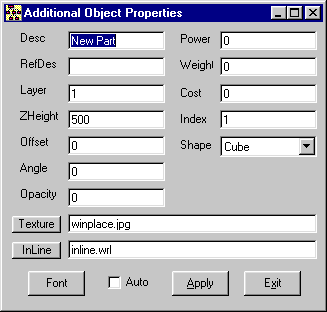 Each of the parts created in a gbVRML project are given certain
properties as they are created (height, width, color, ...). In addition
to the properties seen in the 2D drawing pane, other properties may
be defined for the objects. Most are associated with displaying the
part as a 3D object (ZAxis height, texture, type of VRML primitive, ...).
Each of the parts created in a gbVRML project are given certain
properties as they are created (height, width, color, ...). In addition
to the properties seen in the 2D drawing pane, other properties may
be defined for the objects. Most are associated with displaying the
part as a 3D object (ZAxis height, texture, type of VRML primitive, ...).
Values entered in this window will be lost unless the 'Apply' button is
pressed before the window is closed. However, if the Auto checkbox is
checked then values are saved automatically and their effect displayed in
both the 2D and 3D panes.
 Return to top of document
Return to top of document
Layout Window
 gbVRML uses the concept of a 'layout', which is simply the surface on
which the objects are placed. The layout can be given properties much
like any other part, but it's properties (particularly its top surface
location) is used as the 'home' for many of gbVRML's calcluations.
gbVRML uses the concept of a 'layout', which is simply the surface on
which the objects are placed. The layout can be given properties much
like any other part, but it's properties (particularly its top surface
location) is used as the 'home' for many of gbVRML's calcluations.
gbVRML projects can be set to exclude the layout object if desired.
Values entered in this window will be lost unless the 'Apply' button is
pressed before the window is closed. However, if the Auto checkbox is
checked then values are saved automatically and their effect displayed in
both the 2D and 3D panes.
 Return to top of document
Return to top of document
VRML Source Window
 A VRML source file is simply a text file. The source code for the
currently displayed VRML scene can be viewed here.
A VRML source file is simply a text file. The source code for the
currently displayed VRML scene can be viewed here.
gbVRML also allows you to edit the source code and display the
resulting scene in the VRML viewer. However, the edited code is
not saved nor incorporated into the current project. This feature is
provided for simple experimentation with the VRML source code.
Be careful using this feature! gbVRML cannot capture all possible
source code errors and you project is subject to crashing if you make
a mistake in the code. Be sure to save any unsaved project before using
this feature.
 Return to top of document
Return to top of document
Summary Window
 This window provides a summary of the contents of the current gbVRML
project. Both project level and part level summary information is
show.
This window provides a summary of the contents of the current gbVRML
project. Both project level and part level summary information is
show.
It also adds up the 3 user defined fields (in this example,
power, weight and cost were the 3 user defined field titles). The values
in the user defined fields are assumed to be one-thousandth units, hence
the '0.000' display shown in this window.
 Return to top of document
Return to top of document
Index Window
 This window provides information about the physical materials of which
the objects are made up. For each object you create, you may select one
of these Index entries to represent the object. At this time, none of
the gbVRML features utilizes this information.
This window provides information about the physical materials of which
the objects are made up. For each object you create, you may select one
of these Index entries to represent the object. At this time, none of
the gbVRML features utilizes this information.
 Return to top of document
Return to top of document
Project Parts List
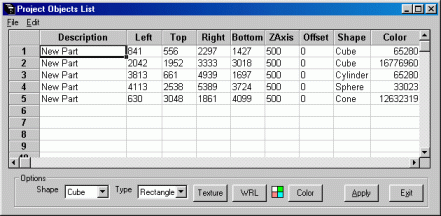 Normally you would right-mouse click on a selected part to get its
property window. However, sometimes you will want to make changes to
many parts at one time, or you might want to import a parts list from
another application such as Excel.
Normally you would right-mouse click on a selected part to get its
property window. However, sometimes you will want to make changes to
many parts at one time, or you might want to import a parts list from
another application such as Excel.
This window supports these, and other functions on the parts list
as a whole. However, take care, because applying the contents of this
window wil erase the main project and replace it with
the list of parts in the spreadsheet.
 Return to top of document
Return to top of document
Installation Problems
 "cannot load internal viewer"
"cannot load internal viewer"
Several of my overseas users get this error. It happens because the
internal VRML viewer in gbVRML requires a period for a decimal separator.
gbVRML now detects which systems do not use the decimal and alert the user
to change the Regional Settings. Many international settings use the comma
for the decimal separator, which will cause gbVRML to fail on startup.
 OCX Registration Failed
OCX Registration Failed
Some users have gone through the installation process successfully only to
find that the first time they run gbVRML they get an error saying that
one of the OCX's distributed with gbVRML is not registered. In these
cases the user must manually register the OCX by going to the directory
where the OCX is installed (\windows\system for Win95/98 or
\winnt\system32 for NT) and executing the following command. The 'xxxx' is
the name of the OCX which did not sucessfully register during the
installation. REGSVR32.EXE is a registration utility normally found on
PCs as part of the Win95/98/NT operating systems. The reason for the
registration problem is not yet understood, although the manual fix seems
to work for most users.
REGSVR32 xxxx.OCX
 Return to top of document
Return to top of document
Design Limitations
 Object Grouping
Object Grouping
Grouping of objects is not fully supported in that some commands in gbVRML
operate only on the group object itself, not on the objects which make up
the group. Most importantly, a 2D group will be displayed in 3D as a single
cube object rather individual displays of the underlying objects.
 VRML Primitives
VRML Primitives
To create the VRML source file, gbVRML assumes that each object in a
project is one of the five VRML primitives (cube, cylinder, cone, sphere,
and text). The 2D drawing pane allows users to create freestyle,
and polygon objects but these objects can only be displayed in the 3D
viewing pane as one of the VRML primitives. This issue will be resolved
in gbVRML Pro but will not be fixed in the freeware version of gbVRML.
The dimension used to determine the size of the VRML primitive is based on
keeping the same footprint (coverage of the layout area) as the rectangle
that bounds the 2D object.
 VRML Text
VRML Text
gbVRML supports flat text, but does not support extruded text.
Text extrusion will be supported in the gbVRML Pro version.
 VRML Background Color
VRML Background Color
While the 2D drawing pane supports all colors, the background for the
3D viewing pane is limited to 16 basic colors. No fix is possible as
this is inherent to the 3rd party 3D viewing control used in gbVRML.
 Return to top of document
Return to top of document
Unfixed Problems
- The 3D pane font does not match the 2D font. This will require some
significant code changes to my VRML source code generator - but I plan
to do this in a future version of gbVRML.
- The displayed 3D text is not accurately aligned with the 2D image. The
3D text is displayed slightly up (in the Y direction). This will be
fixed in a future version

 This page provides the latest online Help information for gbVRML.
This page provides the latest online Help information for gbVRML.


 This page provides the latest online Help information for gbVRML.
This page provides the latest online Help information for gbVRML.






![]() File
File
![]() Edit
Edit
![]() Actions
Actions
![]() VRML
VRML
![]() View
View
![]() Help
Help
![]() Popup
Popup
 Generic information about a gbVRML project may be entered here. In
addition there are 3 part properties which gbVRML allows the user to
define. The titles of those 3 properties are entered here. The total of
the values in each properties are given in the Summary Window.
Generic information about a gbVRML project may be entered here. In
addition there are 3 part properties which gbVRML allows the user to
define. The titles of those 3 properties are entered here. The total of
the values in each properties are given in the Summary Window.
 Each of the parts created in a gbVRML project are given certain
properties as they are created (height, width, color, ...). In addition
to the properties seen in the 2D drawing pane, other properties may
be defined for the objects. Most are associated with displaying the
part as a 3D object (ZAxis height, texture, type of VRML primitive, ...).
Each of the parts created in a gbVRML project are given certain
properties as they are created (height, width, color, ...). In addition
to the properties seen in the 2D drawing pane, other properties may
be defined for the objects. Most are associated with displaying the
part as a 3D object (ZAxis height, texture, type of VRML primitive, ...).
 gbVRML uses the concept of a 'layout', which is simply the surface on
which the objects are placed. The layout can be given properties much
like any other part, but it's properties (particularly its top surface
location) is used as the 'home' for many of gbVRML's calcluations.
gbVRML uses the concept of a 'layout', which is simply the surface on
which the objects are placed. The layout can be given properties much
like any other part, but it's properties (particularly its top surface
location) is used as the 'home' for many of gbVRML's calcluations.
 A VRML source file is simply a text file. The source code for the
currently displayed VRML scene can be viewed here.
A VRML source file is simply a text file. The source code for the
currently displayed VRML scene can be viewed here.
 This window provides a summary of the contents of the current gbVRML
project. Both project level and part level summary information is
show.
This window provides a summary of the contents of the current gbVRML
project. Both project level and part level summary information is
show.
 This window provides information about the physical materials of which
the objects are made up. For each object you create, you may select one
of these Index entries to represent the object. At this time, none of
the gbVRML features utilizes this information.
This window provides information about the physical materials of which
the objects are made up. For each object you create, you may select one
of these Index entries to represent the object. At this time, none of
the gbVRML features utilizes this information.
 Normally you would right-mouse click on a selected part to get its
property window. However, sometimes you will want to make changes to
many parts at one time, or you might want to import a parts list from
another application such as Excel.
Normally you would right-mouse click on a selected part to get its
property window. However, sometimes you will want to make changes to
many parts at one time, or you might want to import a parts list from
another application such as Excel.
![]() OCX Registration Failed
OCX Registration Failed![]() VRML Primitives
VRML Primitives![]() VRML Text
VRML Text![]() VRML Background Color
VRML Background Color